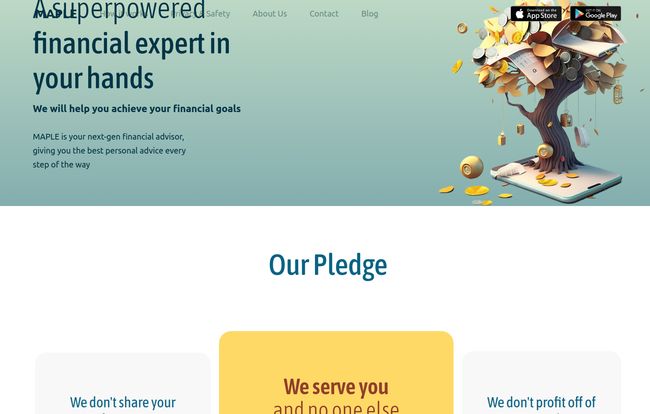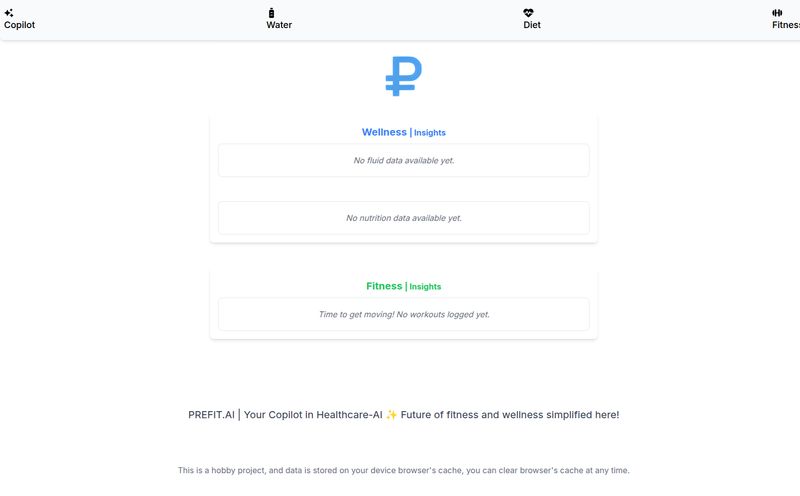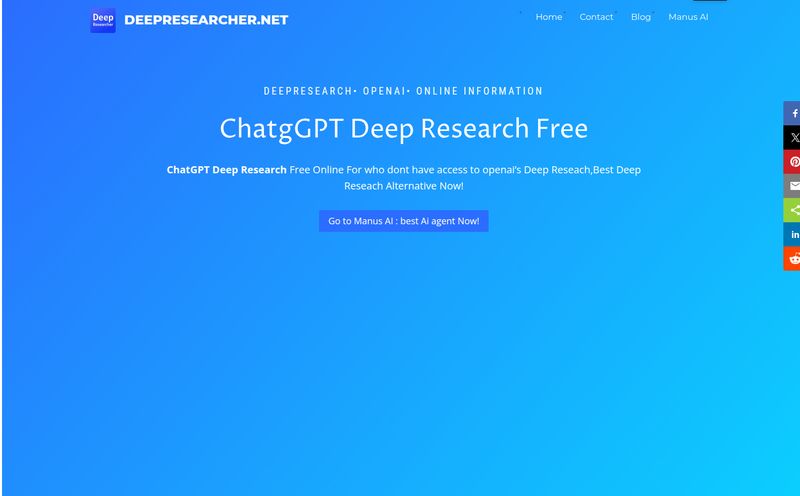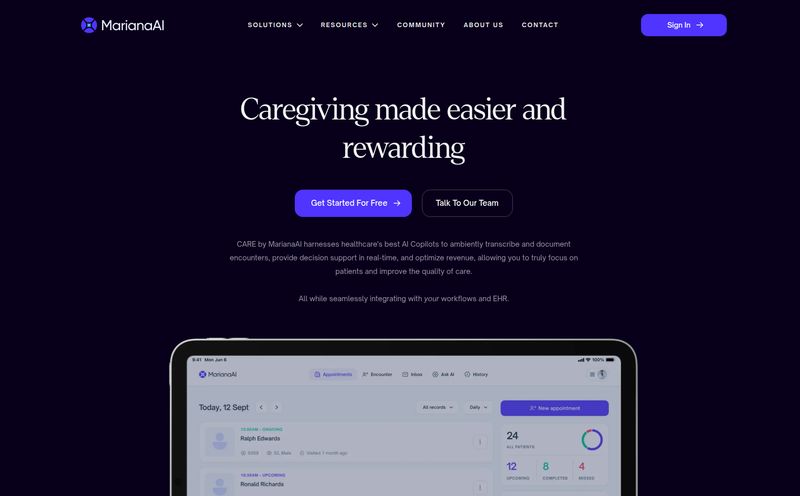I’ve been in the digital marketing and SEO game for years, and if there’s one thing I’ve learned, it’s how to spot a pattern. Every few months, a new app pops up, promising to “revolutionize” some part of our lives. Usually, it’s just a slick new interface slapped onto an old idea. Especially in the fintech world. We’ve all seen them – the budget trackers, the savings apps, the robo-advisors. They come and go.
So when I stumbled across MAPLE, I was… skeptical. Their headline is bold: “A superpowered financial expert in your hands.” Right. Heard that one before. But then I started digging, and I’ll admit, my curiosity got the better of me. This one feels a little different. It’s not just about tracking your spending on lattes; it’s positioned as a full-blown digital financial planner, powered by AI.
But is it just marketing fluff, or is there some real substance here? Let’s take a look together.
First Things First: What is MAPLE Supposed to Be?
In a nutshell, MAPLE aims to be your personal financial strategist that lives on your phone. Think of it less like a simple Mint or YNAB and more like a junior version of a personal CFO. You connect your various accounts—checking, savings, investments, loans—and its AI gets to work.
The goal isn’t just to show you charts of where your money went. It’s designed to give you a comprehensive financial checkup. It analyzes your entire financial picture to provide personalized advice on everything from optimizing your cash flow and analyzing your debt to assessing your risk tolerance and, the big one, figuring out your retirement readiness. It’s trying to be the connective tissue for your entire, often messy, financial life. A single source of truth, if you will.
The MAPLE Pledge: A Refreshing Take on Privacy
Okay, this is the part that really caught my eye. Before we even get into the fancy AI features, let's talk about their core promise. In an era where our data is the product, MAPLE makes a pretty defiant stand. Their pledge is front and center on their website, and it’s worth paying attention to.
They state, unequivocally:
- We don't share your information.
- We don't profit off of your trades.
- No Ads, No Calls.
- No hidden fees.
The most important line, highlighted in a bright yellow box, is “We serve you and no one else.”
Now, for anyone who’s been following the fintech space, that’s a massive statement. We live in the shadow of controversies like Robinhood's Payment for Order Flow (PFOF), where the platform’s revenue model can create a potential conflict of interest. The whole “if it’s free, you’re the product” mantra has made us all a bit cynical, and for good reason. MAPLE seems to be building its entire identity around countering that narrative. This isn't just a feature; it's their entire philosophy. It's a promise to be a fiduciary in digital form, which is a concept I can really get behind.

Visit MAPLE
A Peek Under the Hood: What Can It Actually Do?
So, assuming you trust their pledge, what do you get? MAPLE seems to be packing some serious heat when it comes to features. It’s not just one thing, but a suite of tools working together.
AI-Powered Wealth Management
This is the engine of the whole platform. MAPLE claims its AI goes beyond simple algorithms to provide “micro-personalized” advice. It looks at your assets, your goals, and market conditions to give you recommendations. The idea is that it’s always on, 24/7, growing smarter as it learns more about your financial habits. It's like having a quant analyst constantly looking over your shoulder, but hopefully, less judgmental about your weekend spending.
A Full Financial Checkup, Not Just a Glance
This is where it gets really practical. The platform offers a holistic view by breaking down your finances into several key areas:
- Exposure Review: Are you too heavily invested in one sector? Is your portfolio diversified enough?
- Risk Assessment: Understanding your actual tolerance for risk versus what you think it is.
- Cash Optimization: Is your emergency fund sitting in the right place? Could your idle cash be working harder for you?
- Debt Analysis: Analyzing your loans and credit cards to suggest the smartest payoff strategy.
- Retirement Readiness: The big question. It projects your future wealth and tells you if you're on track to meet your retirement goals. This is probably the most valuable feature for most people.
Let’s Be Real: The Potential Sticking Points
No tool is perfect, and my inner skeptic still has a few questions. To give you a fair picture, we have to talk about the potential downsides.
First, there's the trust leap. To get the most out of MAPLE, you have to connect your financial accounts. You’re handing over the keys to your financial kingdom. They talk a big game about security—multifactor authentication, point-to-point encryption, and anonymizing data for their models—which is exactly what you want to hear. But for some, that initial step of linking a bank or investment account will always be a major hurdle. It's a big ask, plain and simple.
Second, it’s a classic case of “garbage in, garbage out.” The AI is powerful, but its advice is only as good as the data you give it. If you forget to link an old 401k or a secret credit card, the picture it paints will be incomplete, and the advice could be skewed. The onus is on you to be thorough.
Finally, there's a slight lack of clarity on investment specifics. It gives advice and assesses risk, but does it recommend specific ETFs or mutual funds? Or does it just give broad guidance like, “You need more exposure to international equities?” For a seasoned DIY investor, this distinction is critical. The website is a bit vague on this point.
The Million-Dollar Question: What's the Price Tag?
Here’s where things get a bit mysterious. For a platform that champions transparency with its “no hidden fees” pledge, the actual cost is… well, hidden. I couldn’t find a pricing page on their website. I even saw their “Page not found” error when trying to navigate around their blog, which suggests the site might be a work in progress.
This leaves us to speculate. Is it a subscription model? A freemium service where basic features are free and the good stuff is behind a paywall? Without a clear price, it's hard to fully evaluate the value proposition. Personally, I’d rather pay a clear, flat fee for a service like this than wonder how a “free” platform is keeping the lights on. It aligns with their whole “we serve you” ethos. Hopefully, they clarify this soon.
So, Who Is MAPLE Actually For?
I don’t think MAPLE is trying to replace the high-touch, personal relationship you’d have with a dedicated human financial advisor, especially if you have a very complex estate. But it's also clearly a step up from basic budgeting apps.
In my opinion, MAPLE seems perfect for a few types of people:
- The confident beginner who understands the basics but feels overwhelmed trying to connect all the dots on their own.
- The DIY investor who manages their own portfolio but wants an unbiased, AI-powered second opinion to spot weaknesses or opportunities they might have missed.
- The busy professional (that classic HENRY - High Earner, Not Rich Yet) who makes good money but simply doesn't have the time to build complex spreadsheets and track everything manually.
It fills a growing gap in the market between simple tools and expensive human advice.
Final Thoughts on MAPLE
I started out skeptical, but I'm walking away intrigued. MAPLE's privacy-first pledge is a powerful and, frankly, necessary differentiator in today's fintech market. If they can truly deliver on their promise of being an unbiased, AI-powered advisor without succumbing to the temptations of data monetization, they could be onto something big.
It’s not a magic wand. You still have to do the work of providing accurate information and, ultimately, making the decisions. But as a tool to cut through the noise, organize your financial life, and provide a clear path forward, MAPLE is one of the most interesting platforms I’ve seen in a while. I’ll be keeping a close eye on this one, especialy to see how their pricing model shakes out.
Frequently Asked Questions
- What is MAPLE?
- MAPLE is a digital financial planning platform that uses AI to provide personalized financial advice. It connects to your financial accounts to offer a complete checkup, including debt analysis, risk assessment, and retirement readiness planning.
- Is it safe to connect my bank accounts to MAPLE?
- MAPLE emphasizes security, using features like multi-factor authentication and point-to-point encryption for data both at-rest and in-transit. However, connecting any financial account to a third-party app always involves a level of trust and personal risk assessment.
- How does MAPLE make money if it has no ads or hidden fees?
- This is currently the biggest unanswered question. The website doesn't specify its revenue model. It is likely a subscription-based service (monthly or annual fee), but this has not been confirmed by the company yet.
- Can MAPLE replace my human financial advisor?
- For people with straightforward financial situations, MAPLE could provide much of the guidance they need. However, for those with very complex needs, such as estate planning or intricate tax situations, it's probably best viewed as a powerful tool to complement, not replace, the advice of a human professional.
- What kind of financial accounts can I connect to MAPLE?
- While the site doesn't list every supported institution, platforms like this typically use services like Plaid to connect to a wide range of accounts, including checking, savings, credit cards, investment brokerages, 401(k)s, and personal loans.



